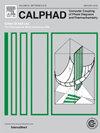Application of polyhedron model to predict heat capacity of mixed oxides
IF 1.9
3区 材料科学
Q4 CHEMISTRY, PHYSICAL
Calphad-computer Coupling of Phase Diagrams and Thermochemistry
Pub Date : 2025-05-20
DOI:10.1016/j.calphad.2025.102836
引用次数: 0
Abstract
The heat capacity of mixed oxides can be estimated using a linear summation of the heat capacities of their structural constituent polyhedra. This approach is particularly useful for hygroscopic and volatile oxides, where experimental data can be difficult to obtain. The present work aims to enhance the polyhedron model (PM) by incorporating contributions from second-order transitions, including magnetic and site order-disorders, into and expanding it to include ZnO and PbO-containing systems in comparison to the previous version of the model. A regression analysis was performed over the new dataset consisting of the properties of 85 compounds in the system Li-Na-K-Ca-Mg-Mn-Fe-Pb-Zn-Al-Ti-Si-O to obtain optimized for 20 constituent polyhedra. We validate the updated PM against experimental data, demonstrating an overall improvement between 7 and 9 % in the estimation of compared to the previous version of the model. We also compare the updated model with well-established models in the literature, such as the Neumann-Kopp Rule, and ab-initio calculations. The PM shows higher precision than NKR and the linear summation nature of PM endows the model with simplicity which contrasts with ab-initio calculations. Additionally, the model has demonstrated an inherent self-correction capability relative to the original input values, as shown for K2Si4O9. The model is also applied to predict the heat capacity of 10 compounds in the Na2O-PbO-SiO2 and Na2O-ZnO-SiO2 systems, where experimental data are lacking.
多面体模型在混合氧化物热容预测中的应用
混合氧化物的热容可以用其结构组成多面体的热容的线性总和来估计。这种方法对于难以获得实验数据的吸湿性和挥发性氧化物特别有用。目前的工作旨在通过将二阶跃迁(包括磁性和位序紊乱)的贡献纳入Cp,并将其扩展到包含ZnO和pbo的体系,从而增强多面体模型(PM)。对Li-Na-K-Ca-Mg-Mn-Fe-Pb-Zn-Al-Ti-Si-O体系中85个化合物的性质进行了回归分析,得到了20个组分多面体的最佳Cp。我们根据实验数据验证了更新后的PM,与之前版本的模型相比,在Cp估计中显示了7%到9%的总体改进。我们还将更新的模型与文献中已建立的模型进行了比较,如诺伊曼-科普规则和从头算。PM比NKR具有更高的精度,PM的线性求和特性使模型与从头计算相比具有简单性。此外,该模型已经证明了相对于原始输入值的固有自校正能力,如K2Si4O9所示。该模型还应用于Na2O-PbO-SiO2和Na2O-ZnO-SiO2体系中10种化合物的热容预测,这是实验数据缺乏的。
本文章由计算机程序翻译,如有差异,请以英文原文为准。
求助全文
约1分钟内获得全文
求助全文
来源期刊
CiteScore
4.00
自引率
16.70%
发文量
94
审稿时长
2.5 months
期刊介绍:
The design of industrial processes requires reliable thermodynamic data. CALPHAD (Computer Coupling of Phase Diagrams and Thermochemistry) aims to promote computational thermodynamics through development of models to represent thermodynamic properties for various phases which permit prediction of properties of multicomponent systems from those of binary and ternary subsystems, critical assessment of data and their incorporation into self-consistent databases, development of software to optimize and derive thermodynamic parameters and the development and use of databanks for calculations to improve understanding of various industrial and technological processes. This work is disseminated through the CALPHAD journal and its annual conference.

 求助内容:
求助内容: 应助结果提醒方式:
应助结果提醒方式:


